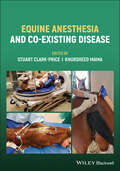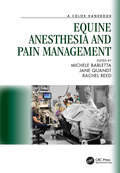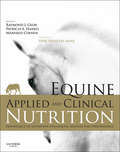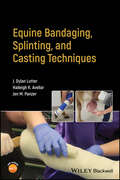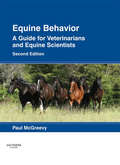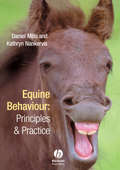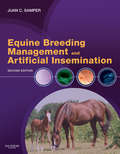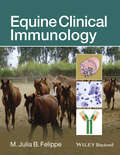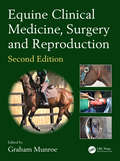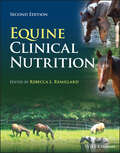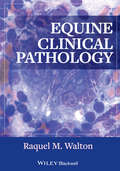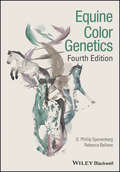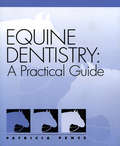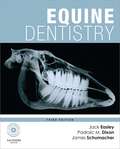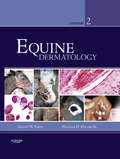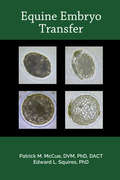- Table View
- List View
Equine Anesthesia and Co-Existing Disease
by Stuart Clark-Price Khursheed MamaEquine Anesthesia and Co-Existing Disease offers practical guidance on anesthetizing horses with pre-existing diseases or other unique conditions. Filling a significant gap in available literature, this authoritative reference is the ideal companion to existing publications on basic management principles, equipment, and complications in equine anesthesia. Detailed chapters, co-authored by anesthesiologists and other allied specialists, offer a body-system approach to anesthesia considerations in horses presenting with a variety of disease conditions. Each chapter contains foundational knowledge such as pathophysiology or diagnostic techniques, clinical images, practical information for pharmacologic selection, and technical requirements for completion of procedures. The text covers equine anesthesia management relevant to respiratory, neuromuscular, and gastrointestinal diseases, cardiac and orthopedic procedures, diagnostic imaging and unique therapies, and more. Designed to allow quick and easy reference to vital information, this valuable clinical resource: Provides complete coverage of anesthetic management of horses with existing conditions or diseases Describes how pre-existing conditions can affect anesthesia in equine patients Includes coverage of accident and error management, induction, and recovery Discusses how anesthesia management differs for other species such as domesticated donkeys and mules Equine Anesthesia and Co-Existing Disease is a must-have reference and clinical guide for everyone involved in the anesthetization of equine patients, including equine general practitioners, anesthesiologists, specialists in related areas, residents in veterinary anesthesiology, and equine anesthesia technicians.
Equine Anesthesia and Co-Existing Disease
by Stuart Clark-Price Khursheed MamaEquine Anesthesia and Co-Existing Disease offers practical guidance on anesthetizing horses with pre-existing diseases or other unique conditions. Filling a significant gap in available literature, this authoritative reference is the ideal companion to existing publications on basic management principles, equipment, and complications in equine anesthesia. Detailed chapters, co-authored by anesthesiologists and other allied specialists, offer a body-system approach to anesthesia considerations in horses presenting with a variety of disease conditions. Each chapter contains foundational knowledge such as pathophysiology or diagnostic techniques, clinical images, practical information for pharmacologic selection, and technical requirements for completion of procedures. The text covers equine anesthesia management relevant to respiratory, neuromuscular, and gastrointestinal diseases, cardiac and orthopedic procedures, diagnostic imaging and unique therapies, and more. Designed to allow quick and easy reference to vital information, this valuable clinical resource: Provides complete coverage of anesthetic management of horses with existing conditions or diseases Describes how pre-existing conditions can affect anesthesia in equine patients Includes coverage of accident and error management, induction, and recovery Discusses how anesthesia management differs for other species such as domesticated donkeys and mules Equine Anesthesia and Co-Existing Disease is a must-have reference and clinical guide for everyone involved in the anesthetization of equine patients, including equine general practitioners, anesthesiologists, specialists in related areas, residents in veterinary anesthesiology, and equine anesthesia technicians.
Equine Anesthesia and Pain Management: A Color Handbook (Veterinary Color Handbook Series)
by Michele Barletta Jane Quandt Rachel ReedEquine Anesthesia and Pain Management: A Color Handbook brings together key information for clinicians in an easy-to-use, problem-orientated format. It disseminates a wealth of knowledge about horse, donkey and mule anesthesia and pain management in a quick reference style, with a focus on clinical practice. Fifteen chapters by expert contributors cover everything from anesthetic equipment, premedication and physical restraint, to total intravenous anesthesia, inhalant anesthesia and partial intravenous anesthesia, recovery, complications and euthanasia. Over 250 superb color photographs and diagrams bring the material to life. This book will be invaluable to all those who need practical information easily to hand, whether equine practitioner, veterinary technician or nurse, or veterinary student.
Equine Anesthesia and Pain Management: A Color Handbook (Veterinary Color Handbook Series)
by Michele Barletta Jane Quandt Rachel ReedEquine Anesthesia and Pain Management: A Color Handbook brings together key information for clinicians in an easy-to-use, problem-orientated format. It disseminates a wealth of knowledge about horse, donkey and mule anesthesia and pain management in a quick reference style, with a focus on clinical practice. Fifteen chapters by expert contributors cover everything from anesthetic equipment, premedication and physical restraint, to total intravenous anesthesia, inhalant anesthesia and partial intravenous anesthesia, recovery, complications and euthanasia. Over 250 superb color photographs and diagrams bring the material to life. This book will be invaluable to all those who need practical information easily to hand, whether equine practitioner, veterinary technician or nurse, or veterinary student.
Equine Applied and Clinical Nutrition E-Book: Health, Welfare and Performance
by Raymond J. Geor Manfred Coenen Patricia HarrisEquine Applied and Clinical Nutrition is a comprehensive text resource on the nutrition and feeding management of horses. Over 20 experts from around the world share their wisdom on a topic of central relevance to all equine practitioners and the equine community generally. Both basic and applied (including healthy and diseased animals) nutrition and feeding management of horses and other equids (i.e. ponies, donkeys, wild equids) are covered. The book will appeal to a wide audienc: undergraduate and post-graduate students in equine science and veterinary medicine, veterinarians, equine nutritionists, horse trainers and owners. The clinical component will strengthen the appeal for equine veterinarians. Equine Applied and Clinical Nutrition will be a "must have" for anyone involved in the care of horses, ponies and other equids. The book is divided into 3 parts: Basic or core nutrition in this context refers to digestive physiology of the horse and the principles of nutrition. Applied nutrition deals with the particular types of foods, and how to maintain an optimum diet through various life stages of the horse. You might characterize this aspect as prevention of disease through diet. Clinical nutrition covers various diseases induced by poor diet, and their dietary treatment and management. It also looks at specific feeding regimes useful in cases disease not specifically induced by diet. Authoritative, international contributions Strong coverage of clinical aspects either omitted from or only sparsely dealt with elsewhere Full colour throughout The only clinical equine nutrition book
Equine Bandaging, Splinting, and Casting Techniques
by J. Dylan Lutter Haileigh K. Avellar Jen M. PanzerEquine Bandaging, Splinting, and Casting Techniques A practical reference manual dealing with a vital component of clinical practice in equine medicine The application of bandages, splints, and casts is an essential part of equine surgical and veterinary care. Traditionally, however, there have been few available resources wholly dedicated to application techniques. The result is that equine veterinary practitioners learn to bandage, splint, and cast on the job, with highly variable results; some practitioners are unwilling even to attempt a cast, spurning this valuable healing tool entirely rather than attempt it from an uncertain base of knowledge. Equine Bandaging, Splinting, and Casting Techniques offers the first comprehensive reference to this specific set of techniques and their applications in equine veterinary medicine. It promises to cultivate a rigorous, clinically tested, consistent standard of care that will improve patient outcomes and long-term owner costs. It is a must-own for any veterinary practitioner who works with equine patients. Equine Bandaging, Splinting, and Casting Techniques readers will also find: Step-by-step organization guides reader smoothly through each process Practical tips and advice for improving quality and appearance of bandages and casts Over 270 color images, including clinical examples and radiographs, supplementing every listed technique Equine Bandaging, Splinting, and Casting Techniques is ideal for all veterinary practitioners, technicians, and students interested in equine care.
Equine Bandaging, Splinting, and Casting Techniques
by J. Dylan Lutter Haileigh K. Avellar Jen M. PanzerEquine Bandaging, Splinting, and Casting Techniques A practical reference manual dealing with a vital component of clinical practice in equine medicine The application of bandages, splints, and casts is an essential part of equine surgical and veterinary care. Traditionally, however, there have been few available resources wholly dedicated to application techniques. The result is that equine veterinary practitioners learn to bandage, splint, and cast on the job, with highly variable results; some practitioners are unwilling even to attempt a cast, spurning this valuable healing tool entirely rather than attempt it from an uncertain base of knowledge. Equine Bandaging, Splinting, and Casting Techniques offers the first comprehensive reference to this specific set of techniques and their applications in equine veterinary medicine. It promises to cultivate a rigorous, clinically tested, consistent standard of care that will improve patient outcomes and long-term owner costs. It is a must-own for any veterinary practitioner who works with equine patients. Equine Bandaging, Splinting, and Casting Techniques readers will also find: Step-by-step organization guides reader smoothly through each process Practical tips and advice for improving quality and appearance of bandages and casts Over 270 color images, including clinical examples and radiographs, supplementing every listed technique Equine Bandaging, Splinting, and Casting Techniques is ideal for all veterinary practitioners, technicians, and students interested in equine care.
Equine Behavior - E-Book: A Guide for Veterinarians and Equine Scientists
by Paul McGreevyEquine Behavior: A guide for Veterinarians and Equine Scientists is the quintessential reference for all who really want to know what makes horses tick.Research in horse behavior has made great strides in recent years. This book examines the truth behind modern trends and ancient traditions. Full of insight, it rounds up the latest findings of practitioners and researchers from all over the world, drawing on both cutting-edge research and best practice. With more than 1,000 references, the book explores equine behavior from first principles, by considering the behavior of free-ranging horses and focusing on ways in which management and training influence the responses of their domestic counterparts. Equine physicians, trainers, handlers and owners all need to be students of equine behavior, because the first sign of a problem is often a change in behavior. So, whether you own, ride, lead, groom, feed or heal horses, what you observe is vital to your understanding.Behavioral problems in the stable and under saddle are a grave concern for equine veterinarians worldwide, because they can lead to poor performance, welfare issues, abuse and, ultimately, wastage. Traditionally, veterinarians gave priority to the physical health of their equine patients. This book is a unique attempt to demonstrate the way science can throw light on how and why problems and unwelcome behaviors arise. It also offers ways to bring about change for the better.Beautifully illustrated with more than 500 photographs and line diagrams, Equine Behavior: A guide for veterinarians and equine scientists is an essential resource for practising veterinarians, students and enthusiasts with a specific interest in horses, ponies, and donkeys. Professional trainers and handlers, equine scientists and behavior therapists will also find its contents invaluable.Paul McGreevy is Senior Lecturer in Animal Behavior at the University of Sydney's Faculty of Veterinary ScienceFeatures a practical, hands-on approach to all aspects of equine behaviorDiscusses all factors that effect equine behaviorContrasts normal behavior with abnormal behaviorReviews all behavioral problemsLists and reviews the latest drug therapiesAddresses difficult-to-treat clinical problems such as head-shaking, with insights from the leading researcher in this areaProvides a brief clinical evaluation of 'horse-whispering'Illustrates the key behavioral differences between horses and donkeys
Equine Behaviour: Principles and Practice
by Daniel S. Mills Kathryn J. NankervisUnderstanding the flexibility and limits of behaviour is essential to improving both the horse's welfare and its performance. This book tackles the fundamental principles which will enable owners, riders, trainers and students to understand scientific principles and apply them in practice. Subjects covered include the analysis of influences on equine behaviour, the perceptual world of the horse, learning and training techniques including the latest developments in "join-up" and "imprint training".
Equine Behaviour: Principles and Practice
by Daniel S. Mills Kathryn J. NankervisUnderstanding the flexibility and limits of behaviour is essential to improving both the horse's welfare and its performance. This book tackles the fundamental principles which will enable owners, riders, trainers and students to understand scientific principles and apply them in practice. Subjects covered include the analysis of influences on equine behaviour, the perceptual world of the horse, learning and training techniques including the latest developments in "join-up" and "imprint training".
Equine Breeding Management and Artificial Insemination
by Juan C. SamperPut the principles of good breeding management into practice with Equine Breeding Management and Artificial Insemination, 2nd Edition for reproductive success! Practical information on the reproductive management of both thoroughbred and warmblood breeding operations prepares you to effectively breed even problem mares and stallions. Plus, detailed content on techniques, procedures, reproductive physiology, and more help you increase reproductive efficiency as well as track and improve your results throughout each breeding season.A section on reproduction efficiency evaluation includes a worksheet to evaluate the performance of both mares and stallions during each breeding season, and helps you compare reproductive performance with previous breeding seasons. Detailed descriptions of procedures and techniques including embryo transfer, artificial insemination, and more enable you to implement the methods for better breeding results. Practical information on reproductive management of both thoroughbred and warmblood breeding operations enhance the fertility of problem mares and stallions. World-renowned authors and contributors with years of practical knowledge and experience provide cutting-edge information. Vibrant full-color design and photographs show accurate representations of clinical appearance.Chapters covering the latest reproductive techniques improve chances of successful breeding, and improve survival rates after the birth of the foal. Vital chapters with information on recognizing potential problems help you quickly identify warning signs before fertility is negatively affected.
Equine Clinical Immunology
by M. Julia B. FelippeEquine Clinical Immunology offers comprehensive information on equine immunological disorders.• Provides a complete, equine-specific reference on clinical immunology • Focuses on clinically relevant information for the diagnosis and treatment of horses with immune disorders • Illustrates the concepts discussed using drawings, photographs, and tables • Presents key concepts, clinical assessment information, and treatment approaches in text boxes for ease of use • Offers a practical, clinically oriented approach ideal for equine specialists
Equine Clinical Immunology
by M. Julia B. FelippeEquine Clinical Immunology offers comprehensive information on equine immunological disorders.• Provides a complete, equine-specific reference on clinical immunology • Focuses on clinically relevant information for the diagnosis and treatment of horses with immune disorders • Illustrates the concepts discussed using drawings, photographs, and tables • Presents key concepts, clinical assessment information, and treatment approaches in text boxes for ease of use • Offers a practical, clinically oriented approach ideal for equine specialists
Equine Clinical Medicine, Surgery and Reproduction
by Graham MunroeThis fully-revised new edition of the best-selling Equine Clinical Medicine, Surgery and Reproduction is supported by over 1800 illustrations of the highest quality: colour photographs, diagnostic images including MRI and CT, and diagrams. System-based, the chapters introduce each individual system with precise information on the relevant basic anatomy and physiology, standard clinical examination techniques and useful differential diagnostic aids. This is followed by diseases and disorders that are pertinent to that system, grouped together either anatomically or based on presenting clinical signs. Each condition is described using consistent headings: definition/overview, etiology and pathophysiology, clinical presentation, diagnosis, differential diagnoses, management/treatment, and prognosis. Additional chapters deal with the foal and wounds. New to the second edition: - All chapters are updated throughout - Additional chapters on the axial musculoskeletal system (neck, back and pelvis) and muscle diseases and problems - A whole new section on soft tissue injuries of the foot - More information on diagnostic tests including over-ground endoscopy, chest and liver ultrasonography, head CT, and foot MRI - Material on equine dentistry, neurology, endocrine system, the foal, and the liver has been considerably expanded - All illustrations and photographs have been reviewed and many replaced with higher quality images. The focus throughout remains on providing clinically relevant information required for practical case management, plus sufficient background on causes and disease processes to enable readers to understand the conditions and the rationale for diagnostic and treatment options. An international group of respected clinicians have come together under the editorship of Dr Graham Munroe to create a textbook that will be of lasting value as a teaching and training resource for equine clinical teachers and their students in veterinary medicine and related equine courses, as well as a ready reference for non-specialist mixed or equine clinical practitioners
Equine Clinical Medicine, Surgery and Reproduction
by Graham MunroeThis fully-revised new edition of the best-selling Equine Clinical Medicine, Surgery and Reproduction is supported by over 1800 illustrations of the highest quality: colour photographs, diagnostic images including MRI and CT, and diagrams. System-based, the chapters introduce each individual system with precise information on the relevant basic anatomy and physiology, standard clinical examination techniques and useful differential diagnostic aids. This is followed by diseases and disorders that are pertinent to that system, grouped together either anatomically or based on presenting clinical signs. Each condition is described using consistent headings: definition/overview, etiology and pathophysiology, clinical presentation, diagnosis, differential diagnoses, management/treatment, and prognosis. Additional chapters deal with the foal and wounds. New to the second edition: - All chapters are updated throughout - Additional chapters on the axial musculoskeletal system (neck, back and pelvis) and muscle diseases and problems - A whole new section on soft tissue injuries of the foot - More information on diagnostic tests including over-ground endoscopy, chest and liver ultrasonography, head CT, and foot MRI - Material on equine dentistry, neurology, endocrine system, the foal, and the liver has been considerably expanded - All illustrations and photographs have been reviewed and many replaced with higher quality images. The focus throughout remains on providing clinically relevant information required for practical case management, plus sufficient background on causes and disease processes to enable readers to understand the conditions and the rationale for diagnostic and treatment options. An international group of respected clinicians have come together under the editorship of Dr Graham Munroe to create a textbook that will be of lasting value as a teaching and training resource for equine clinical teachers and their students in veterinary medicine and related equine courses, as well as a ready reference for non-specialist mixed or equine clinical practitioners
Equine Clinical Nutrition
by Rebecca L. RemillardEQUINE CLINICAL NUTRITION Authoritative resource on the nutritional management of horses, now incorporating the iterative learning process The second edition of Equine Clinical Nutrition is a fully updated and expanded revision of the classic student text on nutritional management of horses, covering updated nutrient recommendations, rations, feeding management, clinical nutrition and many other important topics in the field. To aid in reader comprehension, this new edition takes a new instructional approach to nutritional management using an iterative sequence of defined procedures. Divided into distinct sections for easy accessibility, this book is a comprehensive resource for feeding practices and management of healthy and sick horses alike. A thorough understanding of life stages, anatomy, physiology, and behavior underpins the practice of clinical nutrition. Sample topics covered in Equine Clinical Nutrition include: The evolution of horses to changing food supply, the importance of their microbiome, and the behavior patterns of feeding and drinking Nutrient metabolism of water, energy, protein, minerals, and vitamins, plus ration assessment, farm investigations, forages, and toxic plants Manufactured feeds, dietary supplements, USA feed regulations, and feed safety protocols Nutritional assessment of horses by life stage, recognizing pain and discomfort behaviors, and dietary management of weight and major system disorders Equine Clinical Nutrition is an essential text for students of veterinary medicine, animal science, pre-veterinary programs, and a desk reference for equine practitioners wanting practical clinical feeding recommendations. With comprehensive coverage of the topic, it is an essential text for everything related to nutrition in horses.
Equine Clinical Nutrition
by Rebecca L. RemillardEQUINE CLINICAL NUTRITION Authoritative resource on the nutritional management of horses, now incorporating the iterative learning process The second edition of Equine Clinical Nutrition is a fully updated and expanded revision of the classic student text on nutritional management of horses, covering updated nutrient recommendations, rations, feeding management, clinical nutrition and many other important topics in the field. To aid in reader comprehension, this new edition takes a new instructional approach to nutritional management using an iterative sequence of defined procedures. Divided into distinct sections for easy accessibility, this book is a comprehensive resource for feeding practices and management of healthy and sick horses alike. A thorough understanding of life stages, anatomy, physiology, and behavior underpins the practice of clinical nutrition. Sample topics covered in Equine Clinical Nutrition include: The evolution of horses to changing food supply, the importance of their microbiome, and the behavior patterns of feeding and drinking Nutrient metabolism of water, energy, protein, minerals, and vitamins, plus ration assessment, farm investigations, forages, and toxic plants Manufactured feeds, dietary supplements, USA feed regulations, and feed safety protocols Nutritional assessment of horses by life stage, recognizing pain and discomfort behaviors, and dietary management of weight and major system disorders Equine Clinical Nutrition is an essential text for students of veterinary medicine, animal science, pre-veterinary programs, and a desk reference for equine practitioners wanting practical clinical feeding recommendations. With comprehensive coverage of the topic, it is an essential text for everything related to nutrition in horses.
Equine Clinical Pathology
by Raquel M. WaltonEquine Clinical Pathology is the first complete resource for hematology and clinical chemistry in horses. Encompassing the basic principles and advanced interpretation, the book’s single-species approach to pathology allows for focused coverage of the unique disease characteristics of equids. Equine Clinical Pathology is equally useful for anyone using clinical pathology as a diagnostic tool, from beginning student to experienced specialist. The heart of the book is organized by body system, making it easy to find and apply information. Chapters cover general laboratory medicine, including instruments and techniques, hematology, and proteins as well as specific organs, such as the kidney and liver. Equine Clinical Pathology is a useful bench-side reference for anyone involved in laboratory medicine for the horse.
Equine Clinical Pathology
by Raquel M. WaltonEquine Clinical Pathology is the first complete resource for hematology and clinical chemistry in horses. Encompassing the basic principles and advanced interpretation, the book’s single-species approach to pathology allows for focused coverage of the unique disease characteristics of equids. Equine Clinical Pathology is equally useful for anyone using clinical pathology as a diagnostic tool, from beginning student to experienced specialist. The heart of the book is organized by body system, making it easy to find and apply information. Chapters cover general laboratory medicine, including instruments and techniques, hematology, and proteins as well as specific organs, such as the kidney and liver. Equine Clinical Pathology is a useful bench-side reference for anyone involved in laboratory medicine for the horse.
Equine Color Genetics
by D. Phillip Sponenberg Rebecca BelloneEquine Color Genetics, Fourth Edition presents a detailed examination of the color variation in horses and donkeys and the genetic mechanisms that produce color variations. Thoroughly covers the basic colors in horses, including bay, chestnut, black, and brown Details the genetic basis of the colors built from the basic coat color, including dilutions and white patterning Provides an explanation of genetic mechanisms that determine coat color Presents a thorough revision and update, including new advances in molecular genetics, biochemistry, molecular mechanisms, genetic loci, coat colors before domestication, and more Offers a new introduction describing the principles of genetics and genomics research to help outline how knowledge is discovered and to assist the reader in understanding concepts covered in the book
Equine Color Genetics
by D. Phillip Sponenberg Rebecca BelloneEquine Color Genetics, Fourth Edition presents a detailed examination of the color variation in horses and donkeys and the genetic mechanisms that produce color variations. Thoroughly covers the basic colors in horses, including bay, chestnut, black, and brown Details the genetic basis of the colors built from the basic coat color, including dilutions and white patterning Provides an explanation of genetic mechanisms that determine coat color Presents a thorough revision and update, including new advances in molecular genetics, biochemistry, molecular mechanisms, genetic loci, coat colors before domestication, and more Offers a new introduction describing the principles of genetics and genomics research to help outline how knowledge is discovered and to assist the reader in understanding concepts covered in the book
Equine Dentistry: A Practical Guide
by Patricia PenceDesigned for the practitioner in the field or the clinic, this quick reference manual provides medical and surgical guidance in a practical, concise manner. Procedural in its approach, this text contains many tables, charts and lists, and step-by-step procedures, diagnostic evaluation, and medical and surgical management of all dental problems in the horse.
Equine Dentistry - E-Book
by Mvb PhD Mrcvs, James Schumacher, Dvm Ms Mrcvs Di Dvm Ms Dipl Abvp Equine Padraic DixonA compilation of a wide range of topics discussed by world-renowned experts in the field of equine dentistry. The new edition of this popular resource represents a total revision of previous content and provides the reader with state-of-the-art knowledge of the field. Comprehensive and definitive, Equine Dentistry third edition retains the successful approach of extensive illustration and step-by-step guidance through oral and dental procedures. In addition, it includes many new figures, expanded text sections in key areas and brings to the team two new editors of international repute. Many new contributions from international experts are combined in this text to promote not only the care of horses in regards to oral and dental health but also the education of veterinary professionals in this rapidly developing area.Jack Easley is joined by James Schumacher and Padraic Dixon in the editorial team Seven new chapters reflect the major advances in dental anatomy and disease and also more general advances in analgesia and anesthesia, diagnostic imaging, and dental surgery The brand-new DVD provides visual as well as vocal guidance to techniques of equine dental examination and prophylactic treatment
Equine Dermatology - E-Book
by Danny W. Scott William H. Miller Jr.Diagnose, treat, and manage equine skin disorders with the most comprehensive reference available! With 900 full-color photos, Equine Dermatology covers skin diseases ranging from those that merely annoy the horse to others that interfere with the horse's ability to function in riding, working, or show. Thorough coverage includes essential basics and practical diagnostic methods, therapies, and specific abnormalities and defects. The book describes the structure and function of the skin, and discusses disorders including bacterial, fungal, parasitic, viral, protozoal, allergic, immune-mediated, endocrine, metabolic, and nutritional diseases. It also covers congenital and hereditary defects, pigmentation abnormalities, keratinization defects, environmental skin diseases, and skin tumors. Written by renowned equine dermatologists Danny Scott and Bill Miller, this all-inclusive resource covers the latest dermatologic topics and the newest therapies.Current, comprehensive coverage includes every known equine dermatosis.An emphasis on differential diagnosis includes key differentials and breed predilections for each disease, especially helpful when you have only a specimen and an incomplete history to work with.A consistent format makes it easy to locate information on each skin disorder, including a clinical description, its cause and pathogenesis, clinical features, clinical management, diagnosis, treatment, and any zoonotic aspects.Expert authors Danny W. Scott, DVM, and William H. Miller, Jr., VMD, offer years of knowledge, experience, and their vast image collections.Diagnostic tables in each chapter provide a quick reference for identifying lesions and disorders.An extensive list of references at the end of each chapter includes recommendations for further reading. New coverage of dermatologic conditions includes the latest topics and emerging disorders such as chronic progressive lymphedema, herpesvirus-2-associated dermatitis, salmonella-associated dermatoses, and nodular auricular chondropathy.Updated Diagnostic Methods chapter covers multiple methods of developing a differential diagnosis list based on breed, lesion type, patterns, and location.A focus on common clinical problems highlights the conditions most likely to be seen in practice. Almost 1,000 full-color photos of skin disorders make it easy to distinguish clinical characteristics and variations of normal and abnormal for accurate diagnosis and therapy.
Equine Embryo Transfer
by Patrick M. McCue Edward L. SquiresThis book briefly reviews the history of equine embryo transfer, covering in clinically practical terms the techniques, equipment, and management protocols currently in use. Embryo transfer has become a big business, especially for breeding racing stock (horses and camels), and is therefore a very important aspect of equine practice. Ed Squires and
